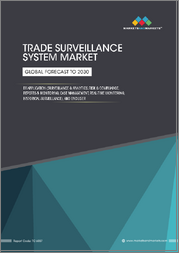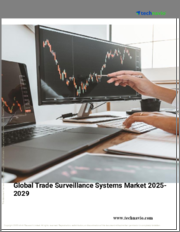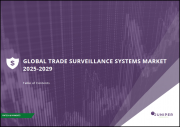
|
시장보고서
상품코드
1701994
거래 감시 시스템 시장 : 컴포넌트별, 전개 모드별, 기업 규모별, 최종사용자별, 지역별(2025-2033년)Trade Surveillance System Market Report by Component, Deployment Mode, Enterprise Size, End User, and Region 2025-2033 |
||||||
거래 감시 시스템 세계 시장 규모는 2024년에 14억 3,960만 달러에 달했습니다. 향후 IMARC Group은 이 시장이 2033년까지 50억 9,700만 달러에 달하고, 2025-2033년 14.33%의 연평균 성장률(CAGR)을 보일 것으로 예측했습니다.
거래 감시 시스템이란 잠재적인 시장 남용 및 기타 유형의 금융 범죄를 감시하고 감지하는 데 사용되는 고급 소프트웨어 솔루션을 말합니다. 거래 데이터를 수집 및 분석하여 사기, 행동 패턴, 시장 조작, 불법 공시, 자금 세탁, 내부자 거래, 부적절한 투자 등 불법 또는 비윤리적인 거래 관행을 식별하는 역할을 합니다. 또한, 불법, 조작적, 남용적 거래 관행을 효율적으로 예방 및 조사하여 정부 규제를 준수하고 회사의 이익을 보호할 수 있도록 지원합니다. 그 결과, 거래 감시 시스템은 거래소, 정보기술(IT) 서비스 제공업체, 정부 규제기관, 컨설팅 회사, 기타 금융기관에서 널리 활용되고 있습니다.
거래 감시 시스템 시장 동향 :
세계적으로 부정거래, 시세조종, 사기의 사례가 증가하고 있는 것이 시장 성장의 주요 요인으로 작용하고 있습니다. 이와 더불어 금융기관의 거래 전후 모니터링에 대한 요구가 높아지면서 거래 감시 시스템에 대한 수요가 증가하고 있습니다. 또한, 자동화 거래 및 알고리즘 트레이딩로의 전환이 진행되면서 거래 조작, 위반 및 부정행위의 위험이 증가하고 있습니다. 이는 규제 준수에 대한 필요성이 증가하면서 시장 성장을 가속하고 있습니다. 또한, 주요 기업들은 경쟁 우위를 확보하기 위해 인공지능(AI), 자연어 처리(NLP), 머신러닝(ML) 등 혁신적인 기술과 통합된 첨단 제품 개발에 많은 투자를 하고 있습니다. 예를 들어, 모니터링 및 위험 감지 기능 강화, 클라우드 아키텍처 개편, 보다 강력한 AI 및 NLP 용도를 탑재한 솔루션을 출시하고 있습니다. 급속한 디지털화, 클라우드 기반 거래 활동 증가, 기술 발전, 보안에 대한 관심 증가 등 다른 요인들도 시장 전망을 밝게 하고 있습니다.
본 보고서에서 다룬 주요 질문
- 2024년 거래 감시 시스템 세계 시장 규모는?
- 2025-2033년 세계 거래 감시 시스템 시장의 예상 성장률은?
- 세계 거래 감시 시스템 시장을 이끄는 주요 요인은?
- 코로나19가 세계 거래 감시 시스템 시장에 미치는 영향은?
- 세계 거래 감시 시스템 시장의 구성요소별 시장 현황은?
- 세계 거래 감시 시스템 시장의 전개 방식별 시장 현황은?
- 기업 규모별 거래 감시 시스템 시장 현황은?
- 세계 거래 감시 시스템 시장의 최종 사용자별 시장 현황은?
- 세계 거래 감시 시스템 시장의 주요 지역은?
- 세계 거래 감시 시스템 시장의 주요 기업은?
목차
제1장 서문
제2장 조사 범위와 조사 방법
- 조사 목적
- 이해관계자
- 데이터 소스
- 1차 정보
- 2차 정보
- 시장 추정
- 보텀업 접근
- 톱다운 접근
- 조사 방법
제3장 주요 요약
제4장 서론
- 개요
- 주요 업계 동향
제5장 세계의 거래 감시 시스템 시장
- 시장 개요
- 시장 실적
- COVID-19의 영향
- 시장 예측
제6장 시장 분석 : 컴포넌트별
- 솔루션
- 서비스
제7장 시장 분석 : 전개 모드별
- On-Premise
- 클라우드 기반
제8장 시장 분석 : 기업 규모별
- 중소기업
- 대기업
제9장 시장 분석 : 최종사용자별
- 은행
- 기관투자가
- 소매 브로커
- 시장 센터 및 규제기관
- 기타
제10장 시장 분석 : 지역별
- 북미
- 미국
- 캐나다
- 아시아태평양
- 중국
- 일본
- 인도
- 한국
- 호주
- 인도네시아
- 기타
- 유럽
- 독일
- 프랑스
- 영국
- 이탈리아
- 스페인
- 러시아
- 기타
- 라틴아메리카
- 브라질
- 멕시코
- 기타
- 중동 및 아프리카
- 시장 내역 : 국가별
제11장 SWOT 분석
- 개요
- 강점
- 약점
- 기회
- 위협
제12장 밸류체인 분석
제13장 Porter의 Five Forces 분석
- 개요
- 바이어의 교섭력
- 공급 기업의 교섭력
- 경쟁 정도
- 신규 진출업체의 위협
- 대체품의 위협
제14장 가격 분석
제15장 경쟁 구도
- 시장 구조
- 주요 기업
- 주요 기업 개요
- ACA Group
- Accenture plc
- Aquis Exchange PLC
- b-next
- Cognizant
- CRISIL Limited(S&P Global Inc.)
- FIS
- International Business Machines Corporation
- Nasdaq Inc.
- NICE Ltd.
- OneMarketData LLC
- SIA S.p.A.
The global trade surveillance system market size reached USD 1,439.6 Million in 2024. Looking forward, IMARC Group expects the market to reach USD 5,097.0 Million by 2033, exhibiting a growth rate (CAGR) of 14.33% during 2025-2033.
A trade surveillance system refers to an advanced software solution used to monitor and detect potential market abuse and other types of financial crimes. It works by capturing and analyzing trade data to identify illegal or unethical trading practices, such as fraud, behavioral patterning, market manipulation, unlawful disclosure, money laundering, insider trading, and unsuitable investments. It also assists organizations to ensure the efficient prevention and investigation of illegal, manipulative, or abusive trading practices to comply with the government regulations and protect the interests of the firm. As a result, trade surveillance systems are widely utilized by trade exchange firms, information technology (IT) service providers, government regulators, consulting firms, and other financial institutions.
Trade Surveillance System Market Trends:
The rising instances of abusive trading, market manipulation and fraud across the globe represent the primary factor driving the market growth. Besides this, the growing need for pre- and post-trade monitoring in financial institutions is augmenting the demand for trade surveillance systems. Additionally, there has been a substantial shift toward automated and algorithmic trading, which has increased the risk of trade manipulation, violation, and fraud. This, in confluence with the surging need for mandatory regulatory compliance, is propelling the market growth. Furthermore, the leading players are heavily investing in the development of advanced product variants integrated with innovative technologies, such as artificial intelligence (AI), natural language processing (NLP), and machine learning (ML), to gain a competitive edge. For instance, they have introduced solutions with enhanced surveillance and risk detection capabilities, an updated cloud architecture, and more powerful AI and NLP applications. Other factors, including rapid digitization, increasing cloud-based trading activities, technological advancements, and rising security concerns, are also creating a positive market outlook.
Key Market Segmentation:
Breakup by Component:
- Solutions
- Services
Breakup by Deployment Mode:
- On-premises
- Cloud-based
Breakup by Enterprise Size:
- Small and Medium-sized Enterprises
- Large Enterprises
Breakup by End User:
- Banks
- Institutional Brokers
- Retail Brokers
- Market Centers and Regulators
- Others
Breakup by Region:
- North America
- United States
- Canada
- Asia-Pacific
- China
- Japan
- India
- South Korea
- Australia
- Indonesia
- Others
- Europe
- Germany
- France
- United Kingdom
- Italy
- Spain
- Russia
- Others
- Latin America
- Brazil
- Mexico
- Others
- Middle East and Africa
Competitive Landscape:
The competitive landscape of the industry has also been examined along with the profiles of the key players being ACA Group, Accenture plc, Aquis Exchange PLC, b-next, Cognizant, CRISIL Limited (S&P Global Inc.), FIS, International Business Machines Corporation, Nasdaq Inc., NICE Ltd., OneMarketData LLC and SIA S.p.A.
Key Questions Answered in This Report
- 1.What was the size of the global trade surveillance system market in 2024?
- 2.What is the expected growth rate of the global trade surveillance system market during 2025-2033?
- 3.What are the key factors driving the global trade surveillance system market?
- 4.What has been the impact of COVID-19 on the global trade surveillance system market?
- 5.What is the breakup of the global trade surveillance system market based on the component?
- 6.What is the breakup of the global trade surveillance system market based on the deployment mode?
- 7.What is the breakup of the global trade surveillance system market based on the enterprise size?
- 8.What is the breakup of the global trade surveillance system market based on the end-user?
- 9.What are the key regions in the global trade surveillance system market?
- 10.Who are the key players/companies in the global trade surveillance system market?
Table of Contents
1 Preface
2 Scope and Methodology
- 2.1 Objectives of the Study
- 2.2 Stakeholders
- 2.3 Data Sources
- 2.3.1 Primary Sources
- 2.3.2 Secondary Sources
- 2.4 Market Estimation
- 2.4.1 Bottom-Up Approach
- 2.4.2 Top-Down Approach
- 2.5 Forecasting Methodology
3 Executive Summary
4 Introduction
- 4.1 Overview
- 4.2 Key Industry Trends
5 Global Trade Surveillance System Market
- 5.1 Market Overview
- 5.2 Market Performance
- 5.3 Impact of COVID-19
- 5.4 Market Forecast
6 Market Breakup by Component
- 6.1 Solutions
- 6.1.1 Market Trends
- 6.1.2 Market Forecast
- 6.2 Services
- 6.2.1 Market Trends
- 6.2.2 Market Forecast
7 Market Breakup by Deployment Mode
- 7.1 On-premises
- 7.1.1 Market Trends
- 7.1.2 Market Forecast
- 7.2 Cloud-based
- 7.2.1 Market Trends
- 7.2.2 Market Forecast
8 Market Breakup by Enterprise Size
- 8.1 Small and Medium-sized Enterprises
- 8.1.1 Market Trends
- 8.1.2 Market Forecast
- 8.2 Large Enterprises
- 8.2.1 Market Trends
- 8.2.2 Market Forecast
9 Market Breakup by End User
- 9.1 Banks
- 9.1.1 Market Trends
- 9.1.2 Market Forecast
- 9.2 Institutional Brokers
- 9.2.1 Market Trends
- 9.2.2 Market Forecast
- 9.3 Retail Brokers
- 9.3.1 Market Trends
- 9.3.2 Market Forecast
- 9.4 Market Centers and Regulators
- 9.4.1 Market Trends
- 9.4.2 Market Forecast
- 9.5 Others
- 9.5.1 Market Trends
- 9.5.2 Market Forecast
10 Market Breakup by Region
- 10.1 North America
- 10.1.1 United States
- 10.1.1.1 Market Trends
- 10.1.1.2 Market Forecast
- 10.1.2 Canada
- 10.1.2.1 Market Trends
- 10.1.2.2 Market Forecast
- 10.1.1 United States
- 10.2 Asia-Pacific
- 10.2.1 China
- 10.2.1.1 Market Trends
- 10.2.1.2 Market Forecast
- 10.2.2 Japan
- 10.2.2.1 Market Trends
- 10.2.2.2 Market Forecast
- 10.2.3 India
- 10.2.3.1 Market Trends
- 10.2.3.2 Market Forecast
- 10.2.4 South Korea
- 10.2.4.1 Market Trends
- 10.2.4.2 Market Forecast
- 10.2.5 Australia
- 10.2.5.1 Market Trends
- 10.2.5.2 Market Forecast
- 10.2.6 Indonesia
- 10.2.6.1 Market Trends
- 10.2.6.2 Market Forecast
- 10.2.7 Others
- 10.2.7.1 Market Trends
- 10.2.7.2 Market Forecast
- 10.2.1 China
- 10.3 Europe
- 10.3.1 Germany
- 10.3.1.1 Market Trends
- 10.3.1.2 Market Forecast
- 10.3.2 France
- 10.3.2.1 Market Trends
- 10.3.2.2 Market Forecast
- 10.3.3 United Kingdom
- 10.3.3.1 Market Trends
- 10.3.3.2 Market Forecast
- 10.3.4 Italy
- 10.3.4.1 Market Trends
- 10.3.4.2 Market Forecast
- 10.3.5 Spain
- 10.3.5.1 Market Trends
- 10.3.5.2 Market Forecast
- 10.3.6 Russia
- 10.3.6.1 Market Trends
- 10.3.6.2 Market Forecast
- 10.3.7 Others
- 10.3.7.1 Market Trends
- 10.3.7.2 Market Forecast
- 10.3.1 Germany
- 10.4 Latin America
- 10.4.1 Brazil
- 10.4.1.1 Market Trends
- 10.4.1.2 Market Forecast
- 10.4.2 Mexico
- 10.4.2.1 Market Trends
- 10.4.2.2 Market Forecast
- 10.4.3 Others
- 10.4.3.1 Market Trends
- 10.4.3.2 Market Forecast
- 10.4.1 Brazil
- 10.5 Middle East and Africa
- 10.5.1 Market Trends
- 10.5.2 Market Breakup by Country
- 10.5.3 Market Forecast
11 SWOT Analysis
- 11.1 Overview
- 11.2 Strengths
- 11.3 Weaknesses
- 11.4 Opportunities
- 11.5 Threats
12 Value Chain Analysis
13 Porters Five Forces Analysis
- 13.1 Overview
- 13.2 Bargaining Power of Buyers
- 13.3 Bargaining Power of Suppliers
- 13.4 Degree of Competition
- 13.5 Threat of New Entrants
- 13.6 Threat of Substitutes
14 Price Analysis
15 Competitive Landscape
- 15.1 Market Structure
- 15.2 Key Players
- 15.3 Profiles of Key Players
- 15.3.1 ACA Group
- 15.3.1.1 Company Overview
- 15.3.1.2 Product Portfolio
- 15.3.2 Accenture plc
- 15.3.2.1 Company Overview
- 15.3.2.2 Product Portfolio
- 15.3.2.3 Financials
- 15.3.2.4 SWOT Analysis
- 15.3.3 Aquis Exchange PLC
- 15.3.3.1 Company Overview
- 15.3.3.2 Product Portfolio
- 15.3.3.3 Financials
- 15.3.4 b-next
- 15.3.4.1 Company Overview
- 15.3.4.2 Product Portfolio
- 15.3.5 Cognizant
- 15.3.5.1 Company Overview
- 15.3.5.2 Product Portfolio
- 15.3.5.3 Financials
- 15.3.5.4 SWOT Analysis
- 15.3.6 CRISIL Limited (S&P Global Inc.)
- 15.3.6.1 Company Overview
- 15.3.6.2 Product Portfolio
- 15.3.6.3 Financials
- 15.3.7 FIS
- 15.3.7.1 Company Overview
- 15.3.7.2 Product Portfolio
- 15.3.7.3 Financials
- 15.3.7.4 SWOT Analysis
- 15.3.8 International Business Machines Corporation
- 15.3.8.1 Company Overview
- 15.3.8.2 Product Portfolio
- 15.3.8.3 Financials
- 15.3.8.4 SWOT Analysis
- 15.3.9 Nasdaq Inc.
- 15.3.9.1 Company Overview
- 15.3.9.2 Product Portfolio
- 15.3.9.3 Financials
- 15.3.9.4 SWOT Analysis
- 15.3.10 NICE Ltd.
- 15.3.10.1 Company Overview
- 15.3.10.2 Product Portfolio
- 15.3.10.3 Financials
- 15.3.10.4 SWOT Analysis
- 15.3.11 OneMarketData LLC
- 15.3.11.1 Company Overview
- 15.3.11.2 Product Portfolio
- 15.3.12 SIA S.p.A.
- 15.3.12.1 Company Overview
- 15.3.12.2 Product Portfolio
- 15.3.12.3 SWOT Analysis
- 15.3.1 ACA Group



















